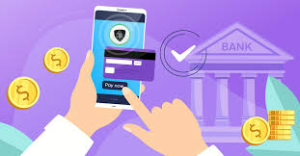In the contemporary landscape of digital finance, managing our monetary affairs online has become an ingrained habit for many. The ease and efficiency of online banking have transformed it into a routine, almost instinctual practice. However, this newfound convenience should come at a cost other than our tranquillity. As technology advances, so do the threats posed by cybercriminals; their tactics are evolving to be more intricate and insidious, jeopardising both our financial assets and sensitive personal information.

Fortunately, there are proactive measures that both banks and consumers can adopt to fortify their defences against these cyber threats. One essential tool in this protective arsenal is multi-factor authentication (MFA), which adds a layer of security to your accounts. Many banking institutions also employ encryption techniques designed to safeguard your personal data and account information from would-be fraudsters. Moreover, there are numerous best practices for password management that individuals can implement further to shield themselves from online banking scams and fraudulent activities.
The surge in popularity of online banking can be attributed to its unparalleled convenience and accessibility. It’s no wonder that a significant majority—over three-quarters—of Americans now prefer conducting their banking activities digitally, as revealed by a March 2022 survey conducted by Ipsos-Forbes Advisor. This shift toward digital platforms benefits not only consumers but also traditional banks; they can streamline operations by reducing costs associated with maintaining physical branches while simultaneously offering more attractive rates on various financial products and services.

Yet, despite these advantages, only some feel ready to embrace the world of online banking fully. A survey by Bankrate highlights that security remains a predominant concern for consumers—96% express apprehension regarding the safety of their accounts and funds when utilising digital platforms. While it’s true that online banking systems have robust security measures in place, they are not infallible; instances of fraud continue to occur regularly. Alarmingly, 42% of consumers reported experiencing some form of personal banking or credit fraud within just the past year.
The repercussions of such fraudulent incidents extend beyond mere financial loss; they create significant stress for customers while simultaneously undermining trust in financial institutions. According to Bankrate’s findings, a staggering 67% of individuals who were alerted about fraudulent activity on their accounts opted to switch banks as a direct result—a clear indication that trust is paramount in maintaining customer loyalty.
As we navigate this increasingly digital realm where convenience meets vulnerability, it becomes essential for both consumers and banks alike to remain vigilant against potential threats while prioritising security measures that protect our finances and personal information from harm’s way.

When engaging in online banking, it’s crucial to be aware of several cybersecurity risks that can jeopardise your personal and financial information. One primary concern is identity theft, which involves the unlawful acquisition of someone’s private details for fraudulent purposes, often leading to financial loss. Criminals may use stolen information to open new credit accounts, submit fake tax returns, or gain unauthorised access to existing accounts.
Another prevalent threat is phishing, a type of cyberattack that typically occurs through email, text messages, or phone calls. In these scenarios, fraudsters masquerade as reputable entities to deceive individuals into revealing sensitive information. They might encourage you to log into your account, change your password, install malicious software, or even transfer funds under pretences. As phishing tactics have become more advanced over time, it’s essential to approach unsolicited communications with caution—regardless of whether they appear to come from a familiar source.

A specific variation of this attack is smishing—phishing conducted via SMS or text messaging. Scammers may send you a message posing as your bank and alerting you about suspicious activity on your account. This could lead you to click on a link that resembles your bank’s login page but is actually designed to capture your credentials if you enter them. Additionally, you might receive phone calls from individuals pretending to be customer service agents aiming to extract personal data.
Malware also poses a significant threat to online banking. This term refers broadly to harmful software intended to disrupt operations or steal sensitive data from computer networks. Types of malware include viruses, spyware that monitors user activity without consent, adware that generates unwanted advertisements, and ransomware that locks users out until a ransom is paid.
Lastly, social engineering scams encompass various deceptive strategies aimed at gaining access to confidential information by exploiting human behaviour and mistakes. These manipulative tactics can sometimes seem harmless but are designed specifically for extracting passwords and other security details from unsuspecting individuals.

Being vigilant against these threats is essential for safeguarding your online banking experience and protecting yourself from potential financial harm.
In the ever-evolving landscape of online banking, a range of crucial security measures has emerged to address the growing threats posed by cybercriminals. Simply entering a username and password is no longer sufficient for securing your accounts. Usernames can often be easily guessed, mainly if they are based on something as familiar as an email address. Furthermore, because many individuals struggle to remember complex passwords, they frequently choose simple ones or reuse them across various platforms. This vulnerability has led to the increased adoption of multi-factor authentication (MFA), which adds an extra layer of security during the login process. Instead of relying solely on your username and password, banks now require an additional form of verification to confirm your identity—this could be a one-time code sent via text message or even biometric methods like fingerprint recognition. Such measures significantly enhance account protection against unauthorised access.
To further safeguard customer data, many financial institutions employ advanced encryption techniques that convert sensitive information into indecipherable code, rendering it useless to hackers or unauthorised users. Another prevalent security measure is Secure Sockets Layer (SSL) technology, which secures internet connections by encrypting data transmitted between your browser and the bank’s website. Additionally, banks often implement routine software updates and patches designed to bolster their security defences in response to emerging threats.

In light of increasing fraud incidents, banks are actively enhancing their protective measures for customers. They invest in robust data encryption and multi-factor authentication technologies as primary barriers against potential breaches. Moreover, features like automatic sign-out serve as simple yet effective safeguards; if a user remains inactive for a certain period during a banking session, this functionality will terminate the session automatically to prevent unauthorised access. Real-time fraud monitoring systems are also being utilised; these sophisticated algorithms continuously analyse transactions for any suspicious activity in order to protect customers proactively from potential fraud attempts.
In online banking, real-time fraud detection systems employ sophisticated algorithms to scrutinise transaction behaviours and identify any irregularities. This technology empowers banks to respond swiftly and safeguard customer accounts. These systems are supported by specialised anti-fraud teams that continuously oversee transactions, monitoring for any signs of suspicious activity that could indicate fraud. Additionally, banks frequently collaborate with cybersecurity firms to bolster their digital defences against potential cyber threats. With the right banking partner in place, even the most advanced risks can be effectively mitigated.

While it is essential for banks to implement strong security measures on their end, businesses also have a crucial role in ensuring their safety while engaging in online banking. Staying informed about cybersecurity trends can provide peace of mind and a sense of control, even in the event of an account compromise. Here are several proactive steps you can take to enhance your account security or minimise damage should fraud occur: avoid using public Wi-Fi networks when accessing your bank’s website or app; utilise multi-factor authentication tools like Google Authenticator alongside your bank’s existing MFA; create robust passwords and change them regularly; consider using a reliable password manager such as 1Password instead of relying on your browser’s storage options; remain vigilant against emerging phishing scams; establish transaction limits and alerts; and set up notifications for fraudulent activities via text or email.
Is it possible to bank securely online? Generally speaking, online banking is relatively safe, but vigilance is critical. Ensure that your bank employs comprehensive security protocols that meet or exceed industry benchmarks while also considering personal precautions. By adopting a proactive approach, you can protect your accounts while enjoying the convenience and accessibility that online banking provides.
Maxthon
In the contemporary world dominated by technology, protecting personal data has reached unprecedented importance. As we engage in various online activities such as banking, shopping, and connecting with others through social media platforms, it is essential to adopt proactive strategies to safeguard our information. It’s all too easy to overlook the significance of online security; however, implementing straightforward practices can significantly enhance the defence of your sensitive data.

Let’s take a moment to consider one of the most effective methods for bolstering your online security: crafting solid passwords. The era when a simple word or phrase was sufficient is long gone. With the evolution of cyber threats, it has become imperative to develop intricate passcodes that are challenging for both people and machines to decipher. A robust password should be comprised of at least eight characters and include a combination of uppercase letters, lowercase letters, numbers, and special symbols.
For example, rather than opting for something as predictable as password1234, you could tap into your creativity. Think about a phrase that holds meaning for you—like “I enjoy sailing on weekends!”—and then transform it into a more complex format such as “ILv4Sailng!” This method not only makes your password more accessible for you to remember but also significantly increases its difficulty level for anyone trying to guess it.
Furthermore, when generating these passwords or user IDs—especially for sensitive accounts like those related to finance—it’s crucial that each one is unique from those employed on other sites. This practice minimises risk in case any single account gets compromised.
Being vigilant about protecting your details is equally vital. Avoid using sensitive information like your Social Security number or credit card information within your passwords or PINs. If cybercriminals manage to gain access to this type of data, they often prioritise targeting it in their attempts to infiltrate accounts.
Another critical element in maintaining online safety involves being able to identify potentially malicious emails. Exercise caution when receiving messages that seem legitimate from well-known entities such as banks or government organisations asking for private information. Always verify before responding or clicking any links contained within those communications.
By taking these steps seriously and remaining aware of potential threats lurking in cyberspace, you can significantly bolster your defences against unauthorised access and keep your personal information secure in an increasingly digital landscape.
